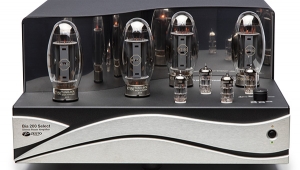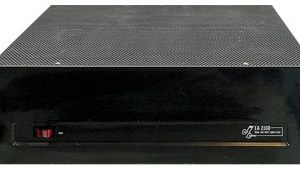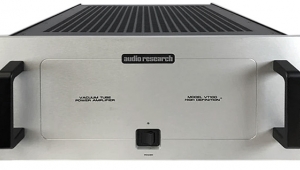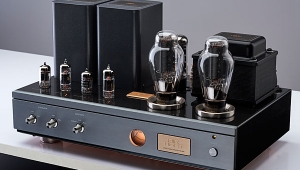| Columns Retired Columns & Blogs |
Nobis Cantabile power amplifier Measurements
Measurements
The Nobis Cantabile ran quite warm after its preconditioning test, but not enough to cause concern. As with all tube amplifiers, it runs quite warm in any case. Its operation was non-inverting, and though it appeared to have some 1/f noise present on its output, this was generally under 10mV and is not something to be concerned about. The unweighted, wide-band S/N ratio measured 65.6dB, referenced to 1W into 8 ohms.
The input impedance of the Nobis was, like many tube amplifiers, quite high: over 320k ohms, making it an easy impedance match for most preamplifiers. Its output impedance from the 8 ohm tap was between 2.5 and 2.64 ohms from 20Hz to 1kHz, rising to 8 ohms (!) at 20kHz. From the 4 ohm tap, these values were reduced to about 1.53 ohms from 20Hz to 1kHz, rising at 20kHz to 4.5 ohms. These high output impedances can be expected to result in noticeable changes in performance with varying loudspeaker loads, much more so, for example, than with the Panor Dynaco ST70 II.
The Nobis's frequency response is shown in fig.1. Note the changes depending on the load impedance and the output tap used. In general, driving an impedance lower than that of the tap used can be expected to result in a considerable, and quite audible, drop in the HF response with the Nobis—which will be somewhat rolled-off at the top in the best case. A major contributor to the rolloff in the bottom curve is most certainly the high output impedance of the Nobis at higher frequencies, especially from the 8 ohm tap. Fig.2 shows the Nobis's 10kHz squarewave response with a 100mV input. The rounded leading edges of the wave are indicative of high-frequency rolloff.

Fig.1 Nobis Cantabile, frequency response at (from top to bottom at 20kHz): 1W into 8 ohms, 4 ohm output tap; 1W into 8 ohms, 8 ohm tap; 2W into 4 ohms, 4 ohm output tap; 2W into 4 ohms, 8 ohm tap (0.5dB/vertical div., right channel dashed).
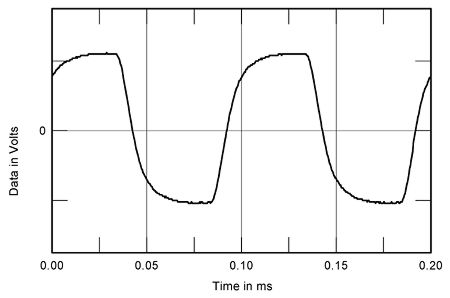
Fig.2 Nobis Cantabile, small-signal 10kHz squarewave into 8 ohms.
That Corey did not find the highs of the Nobis to be rolled-off can be explained by his choice of loudspeaker. The impedance of the ProAc Response Two stays above 9.5 ohms above 500Hz—see Stereophile Vol.15 No.7, p.114—meaning that the resistor-divider action of the amplifier's high output impedance in the extreme treble will be minimal from the 4 ohm tap. By contrast, the new ST70's intrinsic HF rolloff will always be in action no matter what the output tap and the speaker impedance are.
The THD+noise vs frequency response of the Nobis into 8, 4, and 2 ohms is shown in figs.3 (8 ohm tap) and 4 (4 ohm tap). (The 2 ohm load condition was measured with one channel driven.) Note the significant rise in distortion for the right channel with 4 and 8 ohm loads (dotted lines) below about 200Hz in both graphs. Interestingly, the right-channel distortion at higher frequencies is slightly lower than that in the left.

Fig.3 Nobis Cantabile, 8 ohm tap, THD+noise (%) vs frequency at (from bottom to top): 1W into 8 ohms; 2W into 4 ohms; 4W into 2 ohms (right channel dashed).

Fig.4 Nobis Cantabile, 8 ohm tap, THD+noise (%) vs frequency at (from bottom to top): 1W into 8 ohms; 2W into 4 ohms; 4W into 2 ohms (right channel dashed).
The THD+noise vs level for the Nobis is shown in figs.5 (8 ohm tap) and 6 (4 ohm tap). While the previous data may have indicated some possible advantages in driving an 8 ohm load from the 4 ohm tap, note from figs.5 and 6 that these do not come free of charge. Although the distortion for the 4 ohm tap/8 ohm load configuration remains the lowest of all the curves up to about 17W, above this power it rises rapidly, ultimately sacrificing considerable output power—not an insignificant consideration in a low-powered amp. Your own listening conditions and loudspeaker will determine the best choice of output tap to use. Note, however, that driving a low-impedance load from the 8 ohm tap is unlikely to be a desirable combination.

Fig.5 Nobis Cantabile, 8 ohm tap, distortion (%) vs continuous output power into (from bottom to top at 10W): 8 ohms, 4 ohms, and 2 ohms.

Fig.6 Nobis Cantabile, 4 ohm tap, distortion (%) vs continuous output power into (from bottom to top at 10W): 8 ohms, 4 ohms, and 2 ohms.
The Nobis reached 1% distortion (the official onset of clipping) at 1kHz at 35.95W (15.55dBW, left channel, both driven), 36W (15.55dBW, right channel, both driven), and 37.9W (15.8dBW, one channel driven)—for an 8 ohm load driven from the 8 ohm tap. For a 4 ohm load from the 4 ohm tap, corresponding figures were 34.3W (12.35dBW, left channel, both driven), 33.9W (12.3dBW, right channel, both driven), and 36.2W (12.6dBW, one channel driven). The line voltages ranged from 112 to 114.5V.
The results of feeding a 50Hz signal into the Nobis (4 ohm load, 4 ohm tap, 22.2W output) are shown in fig.7. Table 1 shows the harmonics (up to the sixth), the number of dB down the harmonics are from the 50Hz fundamental (to the nearest dB), followed (in parenthesis) by the approximate distortion level this represents. Not shown in the table are the AC power supply harmonics visible at 60Hz, 120Hz, and 180Hz. Although the harmonics appear to be strong, note that they are generally decreasing with frequency (except for the second harmonic at 100Hz), and are all below the 0.5% level.
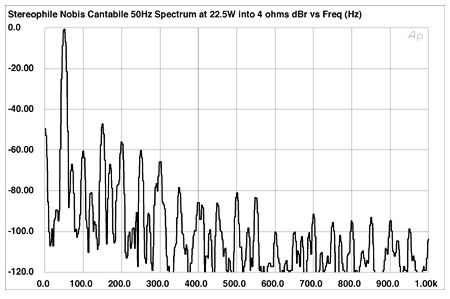
Fig.7 Nobis Cantabile, spectrum of 50Hz sinewave, DC-1kHz, at 22.5W into 4 ohms (linear frequency scale).
Table 1
| Frequency Hz | dB down | (%) |
| 100 | -60 | (0.1%) |
| 150 | -47 | (0.5%) |
| 200 | -55 | (0.17%) |
| 250 | -59 | (0.1%) |
| 300 | -65 | (0.06%) |
| 350 | -78 | (0.015%) |
Fig.8 shows the IM distortion resulting from a combined 19+20kHz signal (17.4W output into a 4 ohm load from the 4 ohm tap). The levels of the artifacts below the fundamentals are shown in Table 2, with the approximate distortion level this represents in parentheses. The distortion is low through most of the audible range, though note that there are power-supply-related sidebands around the two fundamentals noticeable with this high-resolution graph.

Fig.8 Nobis Cantabile, HF intermodulation spectrum, DC-22kHz, 19+20kHz at 17.4W into 4 ohms (linear frequency scale).
Table 2
| Frequency kHz | dB down | (%) |
| 21 | -47 | (0.5%) |
| 18 | -51 | (0.3%) |
| 17 | -55 | (0.18%) |
| 16 | -69 | (0.04%) |
| 15 | -69 | (0.035%) |
| 14 | -88 | (0.004%) |
| 13 | -78 | (0.013%) |
| 12 | -83 | (0.008%) |
| 10 | -82 | (0.008%) |
| 6 | -84 | (0.006%) |
| 5 | -80 | (0.01%) |
| 4 | -76 | (0.015%) |
| 3 | -72 | (0.025%) |
| 2 | -68 | (0.04%) |
| 1 | -54 | (0.2%) |
Finally, the crosstalk performance of the Nobis is shown in fig.9. The rise at the high frequencies, generally caused by capacitive coupling between channels, is typical. There is a difference between channels (that is, the crosstalk from left to right is lower than that from right to left across most of the spectrum), possibly due to differing noise levels, but the performance is generally good.
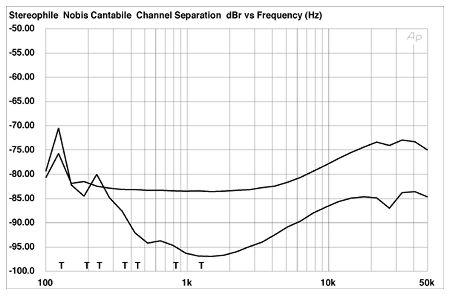
Fig.9 Nobis Cantabile, channel separation: R-L (top) and L-R (5dB/vertical div.).
The Nobis's overall performance, good within its power rating, is not untypical of a modest tube amplifier. Though not quite on a par with the best modern tube designs, the Nobis is also less expensive than most of them. Note, however, that the rather high output impedance calls for very careful loudspeaker matching.—Thomas J. Norton
- Log in or register to post comments
